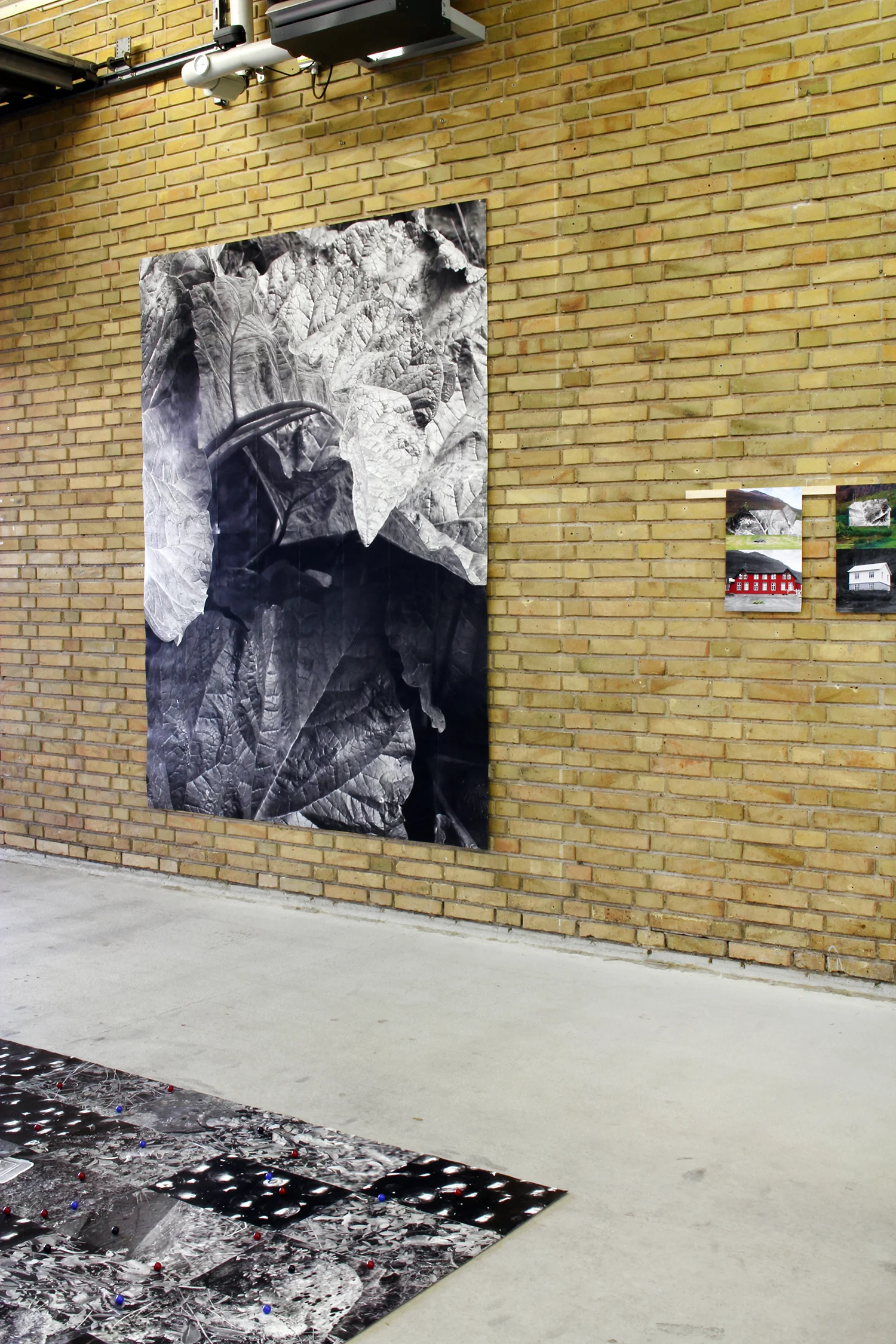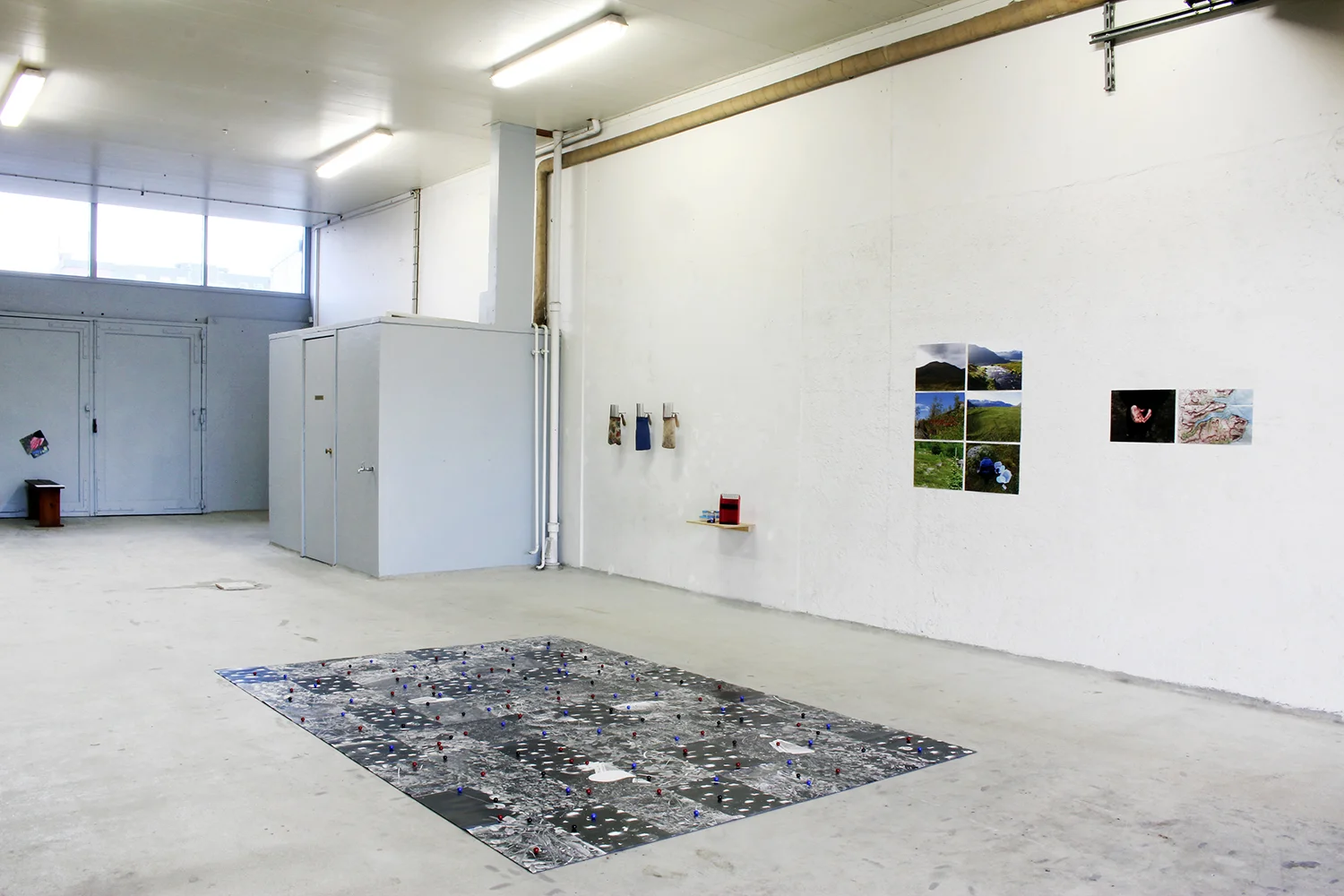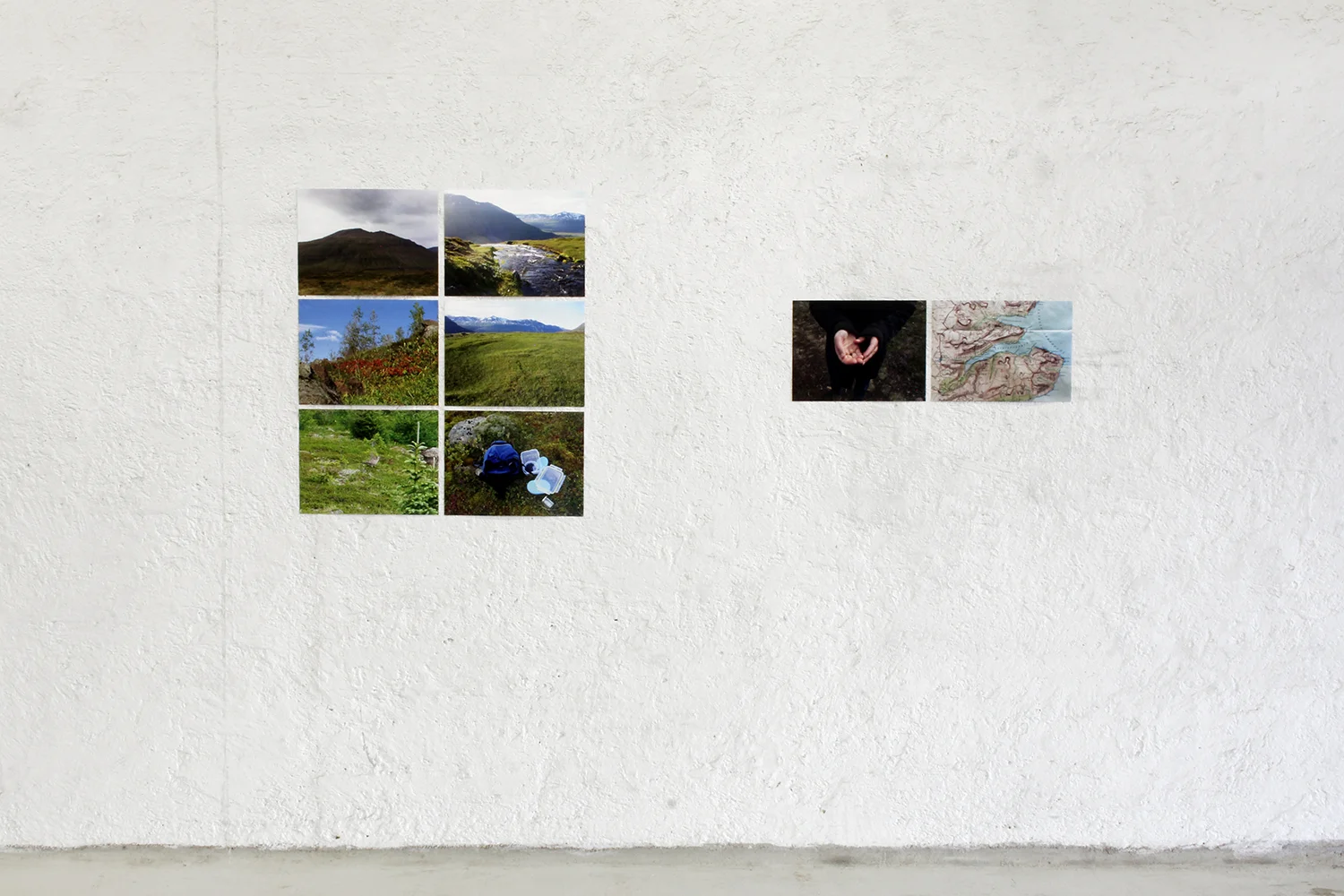JULIA MARTIN: OM BÆRPLUKNING OG RABARBERARKÆOLOGI

Den tyske billedkunstner Julia Martin (f. 1976) viser netop nu Rhubarb Archaeology på det kunstnerdrevne udstillingssted Pirpa på det gamle Grønttorv i Valby. Vi er meget glade for at have hende og hendes projekt som en del af vores udstillingsprogram.
Som ved alle de udstillinger vi har haft, opfordrer vi de udstillende kunstnere til – på den ene eller den anden måde – at tage udgangspunkt i Grønttorvet. Både ifht. stedets historie som samlingspunkt for byens salg af frugt og grønt, men også den igangværende proces med at nedrive de gamle industrielle bygninger og opførelsen af nye boligkomplekser.
Med Julias udstilling Rhubarb Archaeology er der kommet et bidrag, der tager udgangspunkt i, hvordan vi anskaffer os fødevarer, og hvordan vi lever i samspil med produktionen af frugt og grønt. Hvilket landskab bliver skabt i kølvandet på produktionen? Hvor går grænsen mellem en kultiveret, styret produktion og f.eks. en naturlig indsamling af “vilde” bær? Hvilken betydning har vores sanselige og spirituelle forhold til naturen, når det kommer til de globale, klimamæssige problemstillinger, vi står overfor?
Julia Martin, Rhubarb Archaeology. Pirpa, 2018. Fotos © Pirpa.
Julia Martin, Rhubarb Archaeology. Pirpa, 2018. Fotos © Pirpa.
Julia Martin har bosat sig i Seyðisfjörður i det østlige Island, og det er hendes observationer af islandske bærplukningstraditioner (berjamó) og rababerplanternes tilstedeværelse i landskabet, der danner udgangspunkt for hendes undersøgelser. Udstillingen består både af fotografier, film, samt nye og gamle hjemmelavede redskaber til bærplukning. Sensitive, overdimensionerede fotografier af rabarber, collager der viser en sammenhæng mellem huse og rabarberplanter, og hvad der vil ske, hvis menneskene flytter fra deres huse, og rabarberne tager over.
Udstillingen er et resultat af en lang research-proces og et projekt, som ikke er færdigt endnu. Udstillingen Rhubarb Archaeology på Pirpa er blot et skridt på vejen. Sidenhen vil der blive lavet en bog og andre udløbere af projektet. Dette interview er lavet efter en hektisk opsætningsperiode med masser af spændende samtaler, som affødte spørgsmålene herunder.
Julia Martin, Rhubarb Archaeology. Pirpa, 2018. Fotos © Pirpa.
Camilla: I very much like your observations on rhubarb and architecture – an observation I don’t think so many others have done before. The painter I came to think about when we talked was Nikolai Astrup (1880-1928). He made a lot of paintings of very big rhubarb plants, girls and small houses. The rhubarb apparently first came to the Nordic countries in the beginning of the 18th century, so maybe it was something new and exotic when Astrup painted it. Now it’s more looked at as an old farmers thing – a leftover from when we depended on the vegetables we grew. But you turn it around a bit, and I come to think of it as if it was the rhubarb that moved in, and that the people moved out. It took over! As an invasive spieces?
Julia: I have not found much material yet about the arrival of rhubarb in Iceland, but I imagine that it will be a similar story to its arrival in Norway. Quite likely, Norwegian merchants brought their rhubarb with them when moving to Iceland around the end of the 19th century. Luckily, rhubarb doesn't spread as quickly as other imported plants, such as lupine, so it is not a threat to the native flora. But I think in the distribution of rhubarb in the nordic countries we can see migratory patterns that connect populations of animals, people and plants. They are all interdependent.
Julia Martin, Rhubarb Archaeology. Pirpa, 2018. Fotos © Pirpa.
These flows, these cultural and spatial transformations and environmental changes are documented in the way the land is being or has been used, and they can be read like a book if you know what to look for. It’s a kind of archaeology that is not limited to finding ancient monuments or artifacts underground, but is a continuous tracing of all kinds of ephemeral and lasting evidence of ecological existence in the past and present. It involves cultural anthropology as much as landscape studies, geology, and the history of architecture and the arts. What I am fascinated by in this research, is the discovery of complex and complicated human-nonhuman relationships – ecologies, if you like. You start to see the parts of these ecologies as well as the whole, and how these systems endure through change, through evolution, or how they disappear, always depending on how well they adapt to and handle nature's time scales and constellations of events.
Julia Martin, Rhubarb Archaeology. Pirpa, 2018. Fotos © Pirpa.
Camilla: You seem to comment on the industrialization of vegetable and fruit production, by showing us the sensitivity – the way to move in the landscape, the sensual structure of the rhubarb – that we are missing out on. You show us the connection between landscape, people and production, and that berry picking in “the wild” is an action that is both natural and cultural.
Julia: I think that developing and maintaining sensitivity towards the land, finding a balance between wilderness and cultivation is crucial for the future of humankind. But I am not too optimistic that such sensitivity alone will be able to change the course of our current economies any more.
Julia Martin, Rhubarb Archaeology. Pirpa, 2018. Fotos © Pirpa.
In our time, berry picking in the wild is either something of a luxury pastime or a fight for survival. Our structures for habitation, production, and trading have crystallized in ways that seem to make it impossible to grant everyone access to a sensual relationship with the land and with the world.
Not everyone can afford the time to forage at leisure, not everyone can own or visit a garden, not everyone has access to knowledge or places that allows the experience of being pleasantly immersed in nature. In contrast we have armies of professional fruit pickers, slaving away in the orchards where time is money, so that the masses can be fed cheaply. And elsewhere the very poor depend on foraging out of desperate need – not out of enjoyment.
Julia Martin, Rhubarb Archaeology. Pirpa, 2018. Fotos © Pirpa.
It’s something I have come to see since I moved to the countryside: How luxurious and romantic it is in many regards, this idyllic life close to nature that is at the same time blessed with all the comforts of modernity. How heavily subsidized this way of living is, still depending on brutal ecological and human exploitation elsewhere. This is easy to forget when the pollution and noise and the crowds of the big cities are far away, and you have all the berries of the autumn for yourself. At a global level, the distribution of food and other natural resources is shockingly unequal, and we are still proceeding fast in robbing ourselves and each other of these precious resources by destroying the conditions that let them grow.
I wish that everyone on this planet could have access to an experience in nature that is equivalent to the islandic berry picking tradition berjamó, and that this experience would have practical consequences for how people choose to live, consume and vote – that it wouldn't remain a purely aesthetic experience. But I myself am having difficulties being always consequential about how I feel I should act and how I actually act, and in this regard I have no real right to wave the moral finger at other people.
Julia Martin, Rhubarb Archaeology. Pirpa, 2018. Fotos © Pirpa.
Julia Martin, Rhubarb Archaeology. Pirpa, 2018. Fotos © Pirpa.
I think implementing radical structural economic change and ecological justice on a global level will be the only way out. The aesthetic and sensual experiences of nature that are offered for example through foraging practices, or hiking, or looking at images of nature, ground us and encourage the love and the motivation needed for further action. But this necessary action towards systemic change still requires an enormous, unromantic, even messy political and practical effort – it is dangerous and frightening to create an unknown situation and then to step into it.
My hope is that fostering a close, unafraid but respectful relationship with nature will reconnect as many people as possible with an energy and spirituality that is rooted very deeply inside our being, and inside all beings. I think it has to do with sensitivity, perseverance, sharing, and love of all beings. If we can remember and use this energy to create new societies involving humans and nonhumans, we will have a chance to master the massive structural changes that are lying ahead of us.
Julia Martin, Rhubarb Archaeology. Pirpa, 2018. Fotos © Pirpa.
Camilla: You have a combination of art and landscape architecture as a background. This mix of art with another education and different subjects, seem to be more and more common. Can you tell a little bit about that?
Julia: I started out studying landscape architecture with the desire to understand the land around me, and the creative powers that shape it. At the beginning I thought I also wanted to shape landscapes myself, but realized that I was more interested in reading them than in writing them. So my interest moved to the perception of landscape, the idea of nature and of ecology, the philosophy of ecological thinking, always moved by a love for living things and this giant organism that is our world.
I’m glad that I started out in a different discipline – I learned a lot about environmental science, architecture, and political economy on the way, and it made my perspective wider. This background still makes me skeptical about art, sometimes regarded as the highest form of human activity – I don't believe in such a hierarchy of disciplines. Learning about and looking at the natural world and its overlaps with human cultural expressions (what we call natural or cultural landscapes) gives me a feeling of simultaneously seeing great depth and seeing nothing at all. The same happens to me looking at art, or making art. It’s the same search for something that’s almost visible but slips away and reappears as a different apparition.
Julia Martin, Rhubarb Archaeology. Pirpa, 2018. Fotos © Pirpa.
I'm not sure if multidisciplinarity is always a comfortable thing for the practitioner. I spend a lot of time doubting what I do, because I see it from the perspective of my other discipline as well. It is unavoidable.
In the end I think this creates more depth, more complexity, but the price is that there is very rarely a single viewpoint or a final resolution to the topics addressed in my work. It's always more complicated than that which can be shown. The research driven approach doesn't always provide the best material for making a large and sweeping "artistic gesture".
But this openness and complication is what I want, what I think is an undogmatic and relatively accurate description of our world and of how we are able or unable to fully read and comprehend it.
Camilla Nørgård (f. 1965) er uddannet ved det Fynske Kunstakademi og er bl.a. medstifter af det kunstnerdrevne udstillingssted Pirpa på Grønttorvet i Valby. Camilla har bidraget til idoart.dk siden 2017.
















